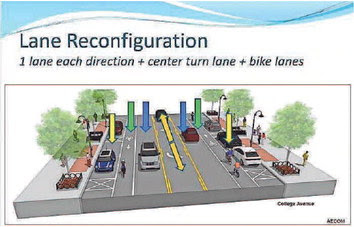Reconfiguration aims to reduce speeds, noise
Duke Behnke | Appleton Post-Crescent USA TODAY NETWORK – WISCONSIN
APPLETON – Motorists driving on College Avenue in downtown Appleton will test a new diet in the coming months.
The Common Council voted 14-1 Wednesday to proceed with the reconfiguration of College Avenue from a four-lane street to a three-lane street — known as a road diet — in an effort to reduce traffic speeds and noise, and to improve safety.
The change will be done as an 18month pilot project, allowing the city to evaluate the results before deciding whether to make it permanent.
Council member Kristin Alfheim asked her colleagues to trust the science behind the design and the expertise of the city traffic engineers who recommended the road diet. “I, for one, am absolutely willing to undo this if it does not work,” Alfheim said. “However, if we don’t do it, we make no progress. I believe it is worth the pain to go through it because I believe it can and will be successful because there is precedent to say so.”
When the road diet was unveiled in January, criticism from the motoring public was swift and strong. A Post-Crescent story about the change generated more than 1,100 comments on Facebook, with many concerned about increasing traffic congestion or diverting traffic away from downtown.
The uproar has dissipated since then, as city officials have met with downtown business owners, held listening sessions and workshops, and provided additional resources and materials about the plan.
Jason Brozek, an associate professor at Lawrence University, urged the council to proceed with the road diet, which includes the addition of bicycle lanes.
“What do we want the city’s downtown to be?” Brozek asked. “Do we want the city’s downtown to be a safe, pleasant place to shop and walk and bike and eat and drink and spend time, or do we want the city’s downtown to be a place for drivers to get through as quickly as possible?”
David Oliver, owner of Mondo! Wine Bar & Retail in downtown Appleton, said he was “enthusiastically in favor” of the road diet. “ This will make a huge difference for people who actually want to come downtown to patronize small business,” Oliver said. “ The people who are cruising up and down College Avenue, they’re not stopping and parking and spending money. They’re just driving up and down for the sake of driving up and down.”
What will change, and how much will it cost?
The change will affect College Avenue between Richmond Street/Memorial Drive and Drew Street.
College currently has two lanes of travel in each direction, plus on-street parking on each side.
With the pilot, the street will have one lane of travel in each direction and a center left-turn lane at each intersection between State Street and Drew. That will create space to add a bicycle lane in each direction. The on-street parking will remain unchanged.
The city budgeted $130,000 for the conversion. It will involve repainting the lane markings and making adjustments to traffic signals.
Council member Chris Croatt voted against the road diet. “I personally think that we can better utilize that money on some of our other infrastructure needs,” he said.
What are the advantages and disadvantages?
Traffic engineers said the road diet will offer the following advantages:
- Reduction in crashes by 19% to 47%.
- Improved left-turn safety due to better sight lines and dedicated leftturn arrows.
- Improved traffic flow, as drivers no longer will get stuck behind someone making a left turn.
- Reduced speeding and thus reduced traffic noise. Drivers no longer will be able to weave through two lanes of traffic.
- Elimination of drag racing.
- Reduction in pedestrian crashes by as much as 80%.
- Addition of dedicated bike lanes for bicyclists and operators of Bird scooters, keeping them off the sidewalks.
One disadvantage will be more traffic congestion during peak periods. It typically takes five minutes to drive between Richmond/Memorial and Meade Street. According to modeling, the change will add about one minute of drive time in the morning and three minutes of drive time in the afternoon for motorists going from one end to the other. Franklin and Lawrence streets, which run parallel to College, have additional capacity to handle motorists who choose to bypass College.
In addition, critics contend that with only one driving lane, traffic will back up while waiting for someone to parallel park. Engineers said the design will allow the motorist who is parallel parking to temporarily occupy the bicycle lane, so the trailing motorists will have sufficient space to pass without leaving the driving lane.
When will the change occur?
The repainting of the lane markings will be done during a two-week period in the summer, depending upon weather and the availability of the contractor. Signal improvements and modifications will done by fall, allowing the pilot to start.
Data collection and traffic monitoring will follow. The pilot project will be reevaluated in spring 2025.
Contact Duke Behnke at 920-9937176 or dbehnke@gannett.com. Follow him on Twitter at @DukeBehnke.


